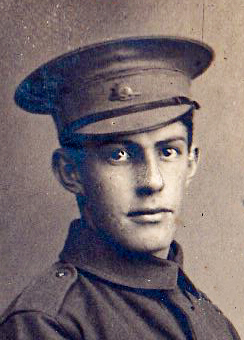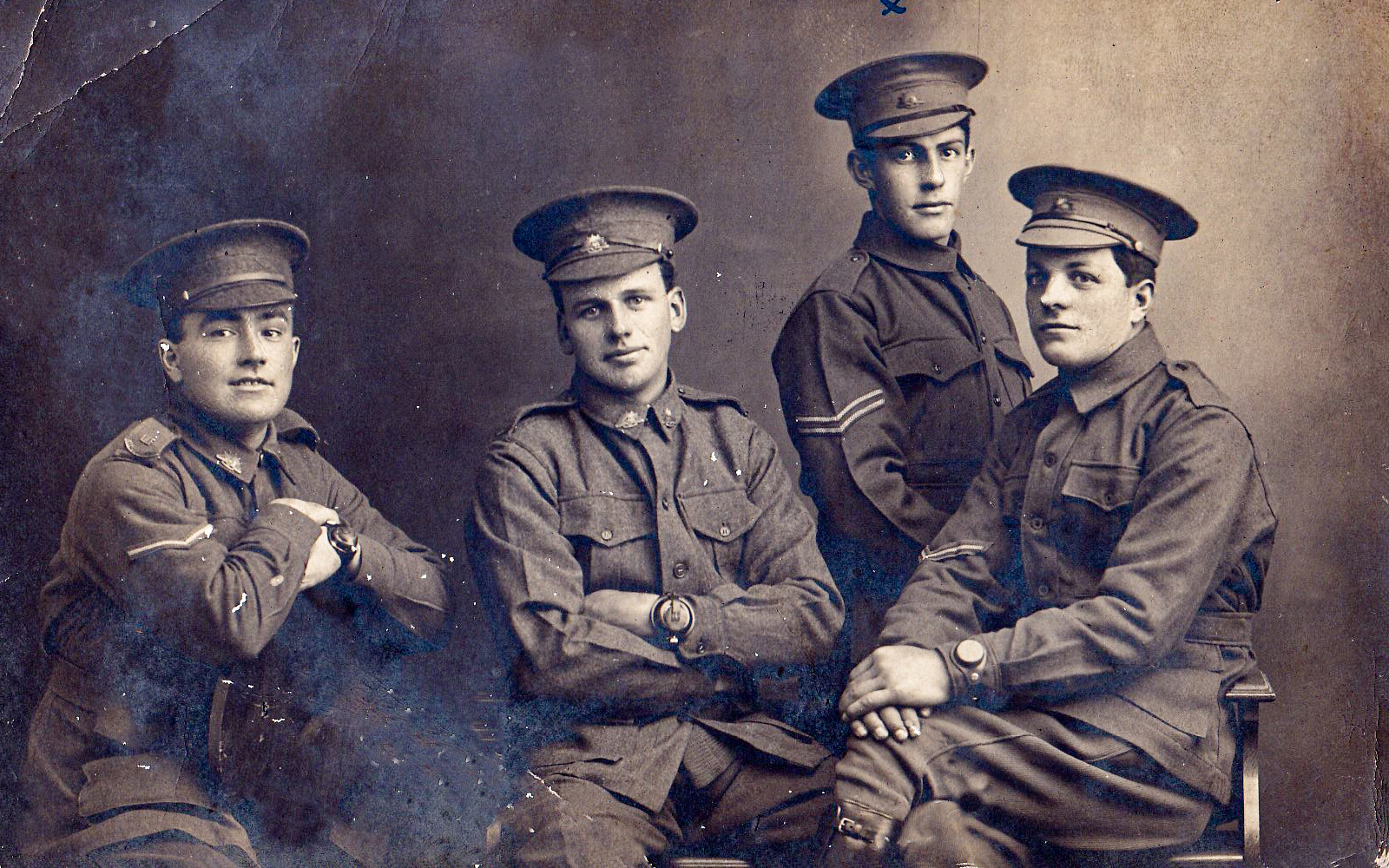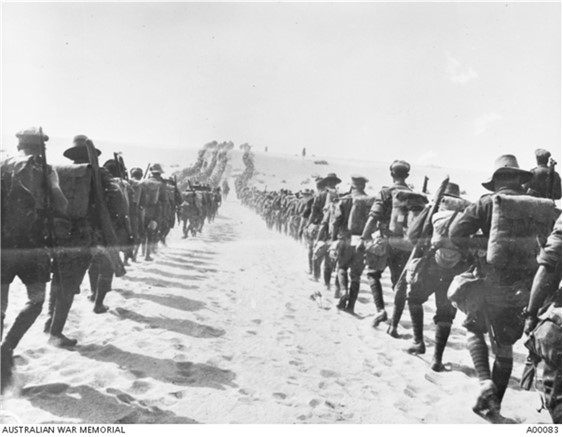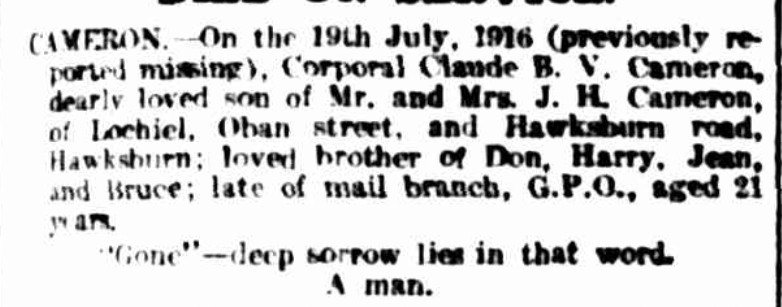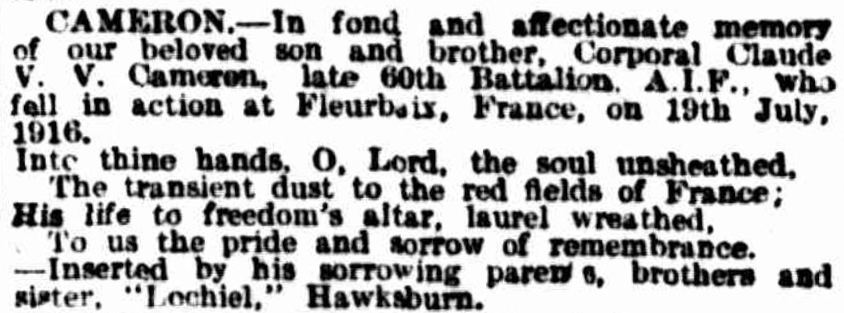Claude Branscombe Vaughan CAMERON
Eyes brown, Hair dark brown, Complexion fresh
Claude Cameron – One of Hawksburn’s Finest
Can Claude be found?
Claude Branscombe Vaughan Cameron was was killed in action at Fromelles on 19th July 1916. Like over 1,300 other Australians lost in that single night, his body was never recovered, he has no known grave.
A mass grave was discovered at Pheasant Wood In 2008 that contained the remains of 250 Australian soldiers recovered by the Germans after the battle. As of 2024, DNA from family members has been used to identify 180 of these soldiers. Claude’s family has come forward to donate DNA and we hope that Claude could be among the remaining unidentified soldiers.
Please contact the Fromelles Association of Australia to find out more.
Early Life
Claude Branscombe Vaughan Cameron was born in 1895 in Brighton, Victoria, the second son of James Harry Philip Cameron and Frosina (Rose) Cameron (née Panam). He grew up in a close-knit Presbyterian family alongside his siblings - Donald, Harry, Jean, and Bruce. Claude’s father was a respected Justice of the Peace. Claude attended Hawksburn State School, where he was later honoured on their Old Scholars' Honour Board, unveiled in 1918, recognising his sacrifice among nearly 600 former students who enlisted.
He continued his education at All Saints Grammar School and Hassetts College, Prahran, demonstrating his academic capability. It led him into clerical work at the mail branch of the General Post Office in Melbourne, a respectable position. He was remembered as a bright, capable, and principled young man.

His early years also included preparation for the military, serving for 18 months with the Senior Cadets and two years with the 49th Infantry, Citizen Military Forces.
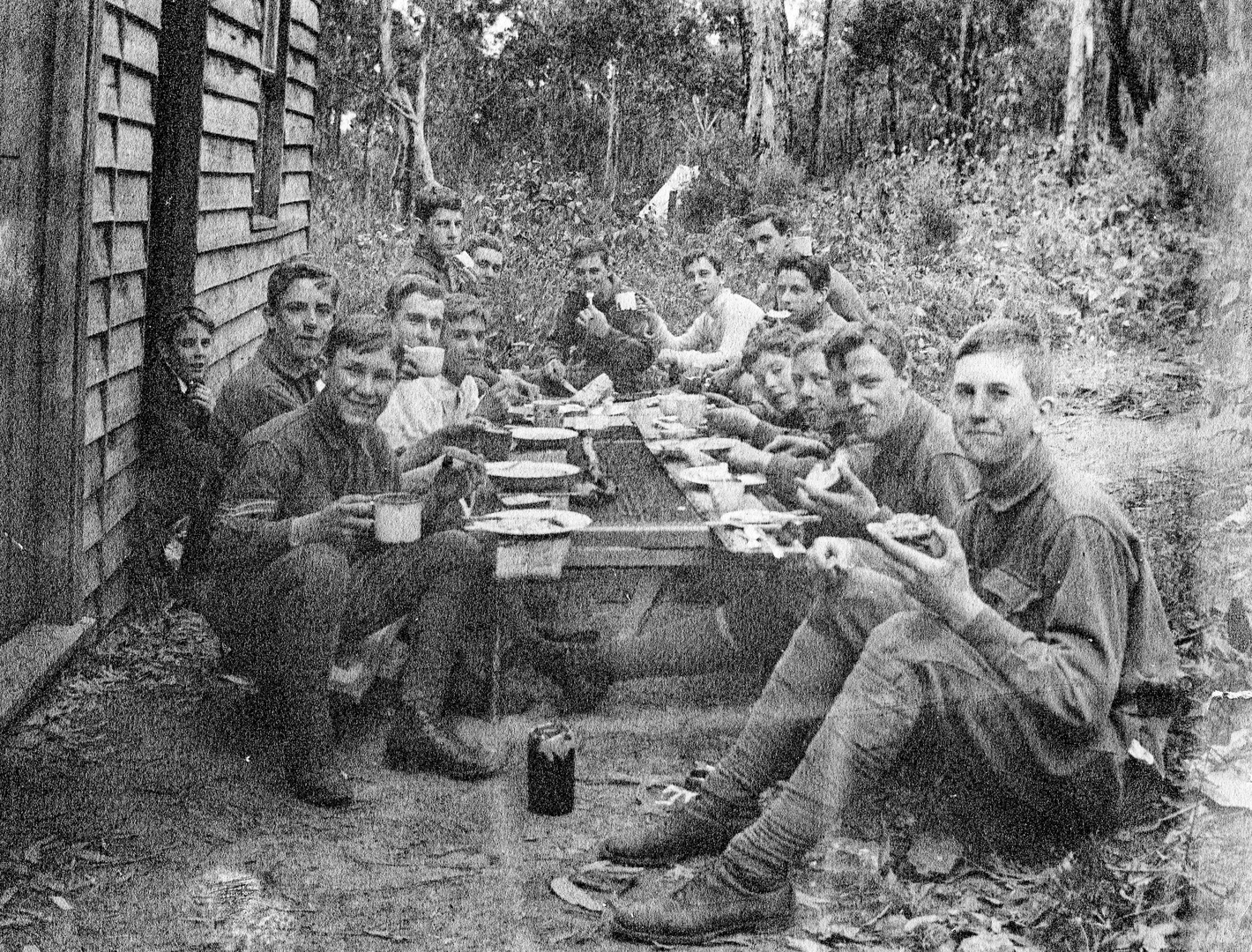
Off to War
With the war escalating, Claude enlisted on 28 June 1915 in Melbourne, aged just 20. He was assigned to the 21st Battalion, 7th Reinforcements. His prior cadet and Citizen Military Forces service enabled him to be appointed as Acting Corporal upon enlistment. Following some brief military training, he embarked from Melbourne on 18 November 1915 aboard HMAT Wiltshire, headed for Egypt.
With the ‘doubling of the AIF’ as it expanded from two infantry divisions to five, major reorganisations were underway when Claude landed. He was reassigned to the newly formed 60th Battalion, which was raised in Egypt on 24 February 1916 at the 40,000-man training camp at Tel-el-Kebir, about 110 km northeast of Cairo. Roughly half of the soldiers in the 60th were Gallipoli veterans from the 8th Battalion, a predominantly Victorian unit, and the other half were fresh reinforcements from Australia.
Although briefly reverted to private in early March as a result of the reorganisations, his position was restored, appointed as Lance Corporal on 13 April at Ferry Post and on 5 June 1916 he was promoted to Corporal. The 60th was inspected by H.R.H the Prince of Wales in mid-March.

After a month of training at the large camp at Tel el Kebir, they had a two+ day, 50 km march in thermometer-bursting heat across the Egyptian sands from Tel el Kebir to Ferry Post, near the Suez Canal. Prior to marching, only ½ pint of water per bottle was available.
Source: AWM4 23/15/1 15th Brigade War Diaries Feb-Mar 1916 page 6
Claude remained at Ferry Post until 1 June, continuing his training and guarding the Suez Canal from any potential threats posed by the Ottoman Army. The 60th’s time in Egypt was not all work, however. A 5th Division Sports Championship was held on 14 June, which was won by the 60th’s 15th brigade. On 17 June they received orders to begin the move to the Western Front and were loaded onto trains to Alexandria. The majority of the battalion, 30 officers and 948 other ranks, embarked on the transport ship Kinfauns Castle on 18 June 1916.
After a stop in Malta, they arrived in Marseilles on 29 June and were immediately put on trains, arriving in Steenbecque in northern France, 35 km from Fleurbaix on 2 July. This area near Fleurbaix was known as the “Nursery Sector” – a supposedly relatively quiet area where inexperienced Allied troops could learn the harsh realities of Western Front trench warfare against the Germans. But the quiet times and the training period did not last long.
On 7 July they began their move to the front, arriving in Sailly on the 9th. Now just a few kilometres from the front, their training continued, although with a higher intensity, I’m sure. The move to Fleurbaix continued and 60th were into the trenches for the first time on 14 July.
The Battle of Fromelles
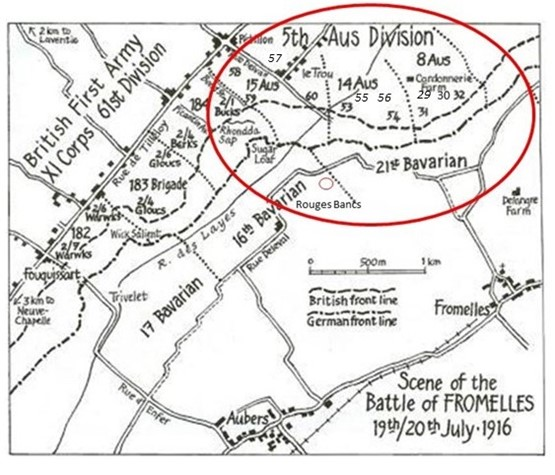
The battle plan had the 15th Brigade located just to the left of the British Army. The 59th and 60th Battalions were to be the lead units for this area of the attack, with the 58th and 57th as the ‘third and fourth’ battalions, in reserve. The main objective for the 15th Brigade was to take the trenches to the left of a heavily armed, elevated German defensive position, the ‘Sugar Loaf’, which dominated the front lines. If the Sugar Loaf could not be taken, the other battalions would be subjected to murderous enfilade fire from the machine-guns and counterattacks from that direction.
As they advanced, they were to link up with the 59th and 53rd Battalions on their flanks. On 17 July, they were in position for the major attack against the Sugar Loaf position, but it was postponed due to unfavourable weather. There was a gas alarm, but luckily it was just that. Two days later Zero Hour for advancing from their front-line trenches was to be 5.45 PM, but the Germans knew this attack was coming and were well-prepared.
They opened a massive artillery bombardment on the Australians at 5.15 PM, causing chaos and many casualties. By 4.20 PM on 19 July Claude was once again in position in the trenches, readying for the attack. Artillery shelling from both sides was constant.
A fellow soldier, Private Bill Boyce (3022, 58th), summed the situation up well:
“What have I let myself in for?”
At 5.45 PM the whistles blew and the first of four waves of Aussies went over the parapet, with the last wave going over at 6.00 PM. Casualties were immediate and heavy. The 15th Brigade War Diaries captures the intensity of the early part of the attack – “they were enfiladed by machine guns in the Sugar Loaf and melted away.”

Sadly, Claude was one of these. Several witnesses described what happened to Claude in stark terms. Private John L. Clancy, 2719 wrote:
“He was killed at Fleurbaix on 19th July. L/Cpl A. Masters told me he saw him killed and that Cameron was the first one he saw go down. Masters is, I think, now with D Company. We know him as ‘Fat’ Masters. Cameron also belonged to the Observation section.”
Corporal Donald Donaldson, 3090A, who served alongside Claude and also lost his brother in the battle, stated:
“This man is C.B. a Corporal. I saw him killed at Fleurbaix, out in No Man’s Land about 7 p.m. on 19th July… Out in No Man’s Land dead, shot by machine gun fire, Fleurbaix. Passed within a yard of him. Thinks it was the same Cameron but was not sure of his number, although initials were similar with addition of ‘V’… When I was coming back through No Man’s Land I saw him dead. I knew him well, came from Australia with him.”
Private Edward Herbert Gibbons, 2501, also gave evidence:
“Refer to Sgt. William Walker of his Co. who can tell of his having been killed. They were great friends and I think ‘Townies.’ I was in this action and knew Cameron well.”
It was reported that some of the 60th got to within 90 yards of the enemy trenches. One soldier said:
”he believed very few of the battalion entered enemy trenches and that during the night a few stragglers, wounded and unwounded, returned to our trenches.”
Fighting continued through the night. With the known high casualties in the 60th, they were relieved by the 57th Battalion at 7.00 AM. Roll call was held at 9.30 AM. C.E.W Bean later wrote:
“of the 60th Battalion, which had gone into the fight with 887 men, only one officer and 106 answered the call.”
To get some perspective of the battle, when Charles Bean, Australia’s official war historian, attended the battlefield two and half years later, he observed a large quantity of bones, torn uniforms and Australian kit still on the battlefield.
The final impact of the battle on the 60th was that 397 soldiers were killed or died of wounds, of which 317 were missing, including Claude.
After the Battle - Family
Claude was never seen alive again. While the witnesses say he was killed near the Australian lines, his body was not recovered. His family endured over a year of uncertainty while the extensive searches by the AIF and the Red Cross were underway. He was not officially declared as having been killed in action on 19 July 1916 at Fromelles by a Court of Enquiry until 4 August 1917.
His parents and siblings mourned his loss deeply. Notices placed in the newspapers spoke of their ongoing grief and pride. However, more sorrow was to follow for the family, as his sister, Jean, died just three years after him in the 1919 influenza epidemic, aged only 20, while nursing patients at Armadale Emergency Hospital.
In 1936, twenty years after his death, his family published:
”The soul of life is in the will to give
The best of life is in willing sacrifice;
Youth only reaches greatness when he dies
In fullest prime that love and truth might live.”
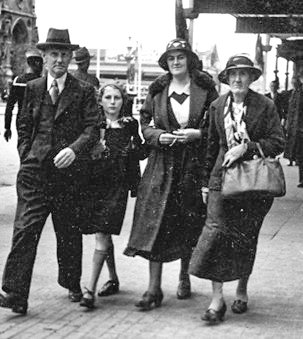
Claude was awarded the British War Medal, the Victory Medal, the 1914-15 Star, a Memorial Plaque and a Memorial Scroll.
Claude’s sacrifice has been honoured in many ways:
- V.C. Corner Australian Cemetery Memorial, Fromelles, where he is listed among those with no known grave.
- Australian War Memorial Roll of Honour, Panel 169, Canberra.
- Hawksburn State School Honour Board, unveiled in 1918 to commemorate former students who served.
- Postmaster General’s Department Honour Boards, Victoria, recognising his service as a clerk in the mail branch of the G.P.O. Melbourne.
Finding Claude?
Claude Branscombe Vaughan Cameron was killed in action at Fromelles on 19 July 1916, aged just 21. Like over a thousand Australians lost in that single night, witnesses saw him fall in No Man’s Land, but his remains were never identified. After the battle, the Germans did recover 250 Australian soldiers and placed them in a burial pit at Pheasant Wood. This grave was discovered in 2008 and since then efforts have been underway to identify these soldiers by DNA testing from family members.
As of 2024, 180 of the soldiers have been identified, including two from the 60th Battalion. Claude’s family have come forward to provide DNA. Their willingness brings hope that one day he will be named and honoured with a known grave.
Please visit Fromelles.info to follow the ongoing identification project and Claude’s story.
DNA samples have been provided for family connections to
| Soldier | Claude Branscombe Vaughan Cameron (1895–1916) |
| Parents | James Harry Philip Cameron (1872–1952) and Frosina Panam (Rose) (1865–1951) |
| Siblings | Donald (1894–1984) | ||
| Harry (1896–1985) | |||
| Jean (1899–1919) | |||
| Bruce (1907–1984) |
| Grandparents | |||
| Paternal | James Harry Branscombe Cameron (1851–1887) and Thirza Miller (1852–1914) | ||
| Maternal | John Panam (1830–1878) and Sarah Jane Laverty (1840–1876) |
Links to Official Records
Seeking DNA Donors

Contacts
(Contact: carla@fromelles.info or geoffrey@fromelles.info).
(Contact: army.uwc@defence.gov.au or phone 1800 019 090).
Donations
If you are able, please contribute to the upkeep of this resource.
(Contact: bill@fromelles.info ).
